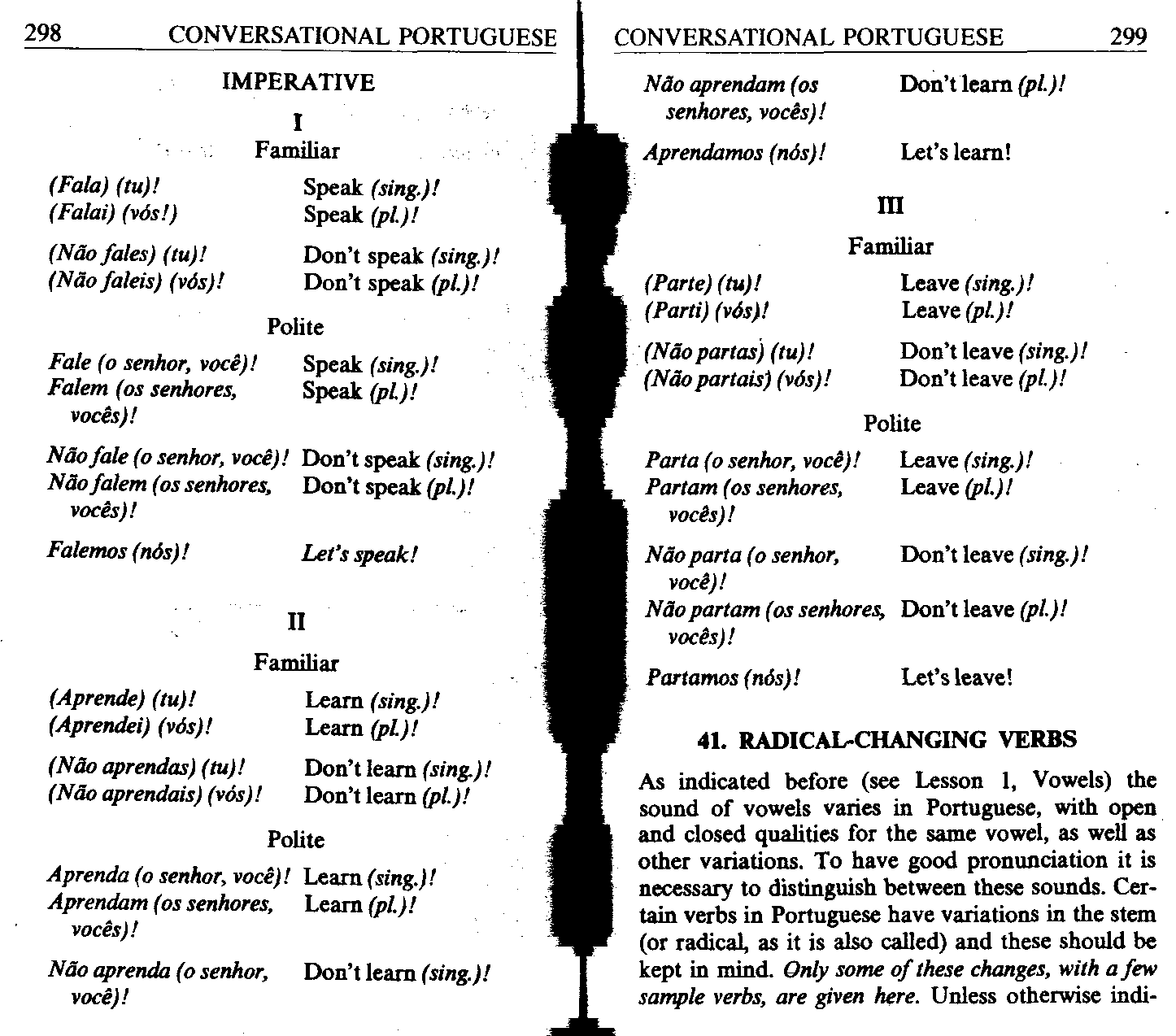Summary p298

298 CONYERSATIONAL PORTUGUESE
IMPERATIYE
I
Familiar
(Fala) (tu)!
(Falai) (vós!)
(Ndo fales) (tu)! (Ndo faleis) (vós)f
Speak (sing,)!
Speak (pi.)!
Don’t speak (sing.)! Don’t speak (pi)!
Polite
Speak (sing.)! Speak (pi)!
Fale (o senhor, voce)! Fałem (os senhores, voces)!
Nao fale (o senhor, voce)! Don’t speak (sing.)! Ndo fałem (os senhores, Don*t speak (pi)!
vocis)!
Falemos (nós)i
Let*s speak!
II
Familiar
(Aprende) (tu)! (Aprendei) (vós)!
(Ndo aprendas) (tu)! (Ndo aprendais) (vós)!
Leara (sing.)! Learn (pl.)!
Don’t leam (sing)! Don’t leam (pi)!
Polite
Aprenda (o senhor, voce)! Learn (sing.)! Aprendam (os senhores, Leam (pl.)!
voces)!
Ndo aprenda (o senhor, Don’t leam (sing.) !
voce)!

Ndo aprendam (os Don’t leam (pl.)!
senhores, voces)!
Aprendamos (nós)l Let’s leam!
m
Familiar
(Parte) (tu)! Leave (sing.)!
(Parti) (vós)! Leave (pl)!
(Nao parias) (tu)! Don’t leave (sing.)!
(Ndo partais) (vós)! Don’t leave (pl.)!
Polite
Parta (o senhor; voci)! Leave (sing.)!
Partam (os senhores, Lea ve (pl)!
vocis)!
Ndo parta (o senhor, Don’t leave (sing.)!
voci)!
Ndo partam (os senhores, Don’t leave (pl.)! voces)I
Partamos (nós)! Let*s leave!
41. RADICAL-CHANGING VERBS
As indicated before (see Lesson 1, Vowels) the sound of vowels varies in Portuguese, with open and closed qualitie$ for the same vowel, as well as other variations. To have good pronunciation it is necessary to distinguish between these sounds. Cer-tain verbs in Portuguese have variations in the stem (or radical, as it is also called) and these should be kept in mind. Only some of these changes, with a few sample verbs, are given hęre. Unless otherwise indi-
Wyszukiwarka
Podobne podstrony:
Summary p222 222 CONYERSATIONAL PORTUGUESE 21. Vamos_(to have dinner). a. jantar
Summary p224 224 CONYERSATIONAL PORTUGUESE (3) variations occur in different areas: a.
Summary p226 226 CONYERSATIONAL PORTUGUESH CONYERSATIONAL PORTUGUESE 227 d g g h j I I Ut m as d i
Summary p230 230 CONYERSATIONAL PORTUGUESE 3, The cedilla (cedilha) is used with
Summary p234 234 CONYERSATIONAL PORTUGUESE k. with parts of the body and articles of clothing inst
Summary p236 236 CONYERSATIONAL PORTUGUESE De and em combine with the demonstrative forms (see GS2
Summary p238 238 CONYERSATIONAL PORTUGUESE 13. MASCULINE AND FEMININE 238 CONYERSATIONAL PORTUGUES
Summary p240 240 CONYERSATIONAL PORTUGUESE 14. THE PLURAL 1. Nouns ending in a vowel, including na
Summary p242 242 CONYERSATIONAL PORTUGUESE seu can also be used to translate “his,” “her,” “their.
Summary p246 246 CONYERSATIONAL PORTUGUESE 1«. COMPAR1SON 1. Rcgular comparison facil easy ma
Summary p248 248 CONYERSATIONAL PORTUGUESE 19. PRONOUNS Pronouns have varying forms depending on w
Summary p250 250 CONYERSATIONAL PORTUGUESE CONYERSATIONAL PORTUGUESE_ 251 (te) I
Summary p254 254 CONYERSATIONAL PORTUGUESE Nao me escreva mais. Eles decidiram que nos mandar
Summary p256 256 CONYERSATIONAL PORTUGUESE 21. SOME CONJUNCTIONS ainda que assim que ate
Summary p258 258 CONYERSATIONAL PORTUGUESE 23. ADYERBS 1. Some Portuguese adverbs are formed by ad
Summary p260 260 CONYERSATIONAL PORTUGUESE la (acold) there (morę remote) adiante . forward,
Summary p262 262 CONYERSATIONAL PORTUGUESE sabdo soap sabonete a cake of toilet
Summary p264 264 CONYERSATIONAL PORTUGUESE Ndo ąuero este sem I don’t want this one
Summary p266 266 CONYERSATIONAL PORTUGUESE27. NEGATION 1. Ndo “not” comes before
więcej podobnych podstron